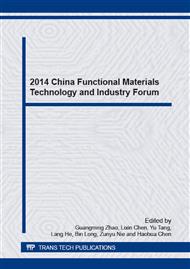p.724
p.731
p.737
p.750
p.757
p.764
p.770
p.781
p.787
Influence of the Particle Size on the Rheology of Magnetorheological Elastomer
Abstract:
In this paper, the correlation between the particle size and rheological properties of MRE was discussed through both experimental results and theoretical analysis. It shows that the particle size can significantly influence the magnetorheological effect by changing the initial shear modulus and the saturated magnetic-induced shear modulus . With an increase in the particle size, the initial shear modulus gets lower, and the saturated magnetic-induced shear modulus increases to the maximum and then decreases. The larger the particle size is, the longer the distance between neighbor particles along the magnetic field is. Based on the relationship between the particle size and shear modulus, there exists an optimum size for added particles. Moreover, the performance of MRE can be improved by optimizing the particle size based on those rules.
Info:
Periodical:
Pages:
757-763
Citation:
Online since:
December 2014
Authors:
Price:
Сopyright:
© 2015 Trans Tech Publications Ltd. All Rights Reserved
Share:
Citation:


